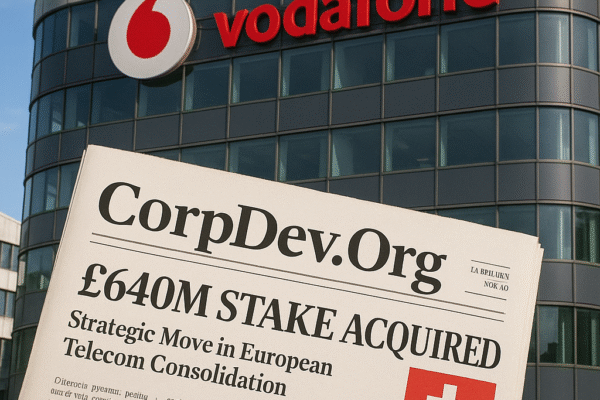Uber Technologies Inc. is negotiating a strategic partnership with former CEO Travis Kalanick to fund his acquisition of Pony.ai’s U.S. operations, marking a dramatic corporate reconciliation and signaling Uber’s urgent response to Waymo and Tesla’s robotaxi dominance. Preliminary talks involve Uber providing capital for Kalanick’s buyout of the Chinese AV firm’s American subsidiary, which would position Kalanick as CEO of the spun-off entity while maintaining leadership at CloudKitchens. This maneuver addresses Uber’s vulnerability in the autonomous vehicle race, where it risks disintermediation by competitors operating driverless fleets, while leveraging geopolitical tensions that forced Pony.ai to silo its U.S. operations since 2022. The potential deal underscores autonomous driving’s critical inflection point, with robotaxis transitioning from pilot programs to commercial scalability across major U.S. markets[1][3][4][6][9][10][13].
💼 Seasoned CorpDev / M&A / PE expertise
Deal Architecture and Strategic Rationale
Transaction Mechanics and Leadership Dynamics
Under the proposed structure, Kalanick would utilize Uber’s capital to acquire Pony.ai’s U.S. subsidiary—a distinct entity operationally and technologically segregated from its Chinese parent since 2022. The separation originated from Executive Order 13873 compliance, which mandated U.S.-developed source code and infrastructure to mitigate national security concerns. Kalanick would assume dual CEO roles: continuing at CloudKitchens while directing the newly independent AV firm, creating an unconventional leadership arrangement requiring bifurcated operational focus. Financial terms remain undisclosed, though Pony.ai’s Nasdaq-listed shares surged 21% following initial reports, reflecting market optimism about the deal’s potential to unlock value in the underperforming U.S. division[1][3][5][8][10][14].
Uber’s Competitive Imperatives
Uber’s participation stems from existential threats in its core ride-hailing business, where Waymo’s expansion across San Francisco, Phoenix, and Austin has demonstrated consumer willingness to pay premium prices for autonomous rides. Tesla’s June 2025 robotaxi launch in Austin further accelerated competitive pressure, creating investor anxiety about Uber’s human-driver dependency. By backing Kalanick, Uber secures preferential access to Pony.ai’s autonomous stack while maintaining its capital-light partnership model—avoiding the R&D costs that plagued its earlier, failed AV initiatives. This aligns with CEO Dara Khosrowshahi’s strategy of embedding third-party AV solutions into Uber’s platform, evidenced by existing integrations with Waymo, May Mobility, and WeRide across 18 global markets[1][4][6][7][11][13].
Kalanick’s Strategic Repositioning
For Kalanick, the deal represents both vindication and redemption—a return to the autonomous vision he championed during his Uber tenure before being ousted in 2017. His public commentary reveals lingering conviction that Uber abandoned AV leadership prematurely, stating at a March 2025 event: “Wish we had an autonomous ride-sharing product right now. That would be great.” The acquisition enables Kalanick to bypass startup scaling challenges by acquiring Pony.ai’s mature technology stack, which holds California DMV permits for driverless testing and established infrastructure. Crucially, it positions him to compete directly against Uber’s AV partners—an ironic twist given Uber’s potential financial backing[4][10][13][14].
Pony.ai’s Geopolitical Journey
Corporate Evolution and Market Pressures
Founded in 2016 with dual headquarters in Fremont and Guangzhou, Pony.ai pioneered integrated autonomous solutions for ride-hailing and logistics, securing $1.3 billion in pre-IPO funding from Toyota, Sequoia China, and Nio Capital. Its 2024 Nasdaq debut raised $260 million at a $4.5 billion valuation, but geopolitical friction immediately constrained growth. The U.S. division generated just 1% of group revenue ($50 million) in 2024, hampered by regulatory barriers limiting technology transfer between Chinese and American teams. This underperformance, coupled with investor pressure to unlock value, prompted the board to explore divestiture options for the U.S. entity as early as 2022—a strategic pivot requiring complete operational bifurcation[1][3][9][10][15].
Technology Segmentation
Pony.ai executed a comprehensive “forking” strategy in 2022, creating parallel development pipelines: Chinese engineers focused on Beijing/Guangzhou deployments while U.S. teams built independent software in Silicon Valley. This duplication addressed Committee on Foreign Investment in the United States (CFIUS) concerns but doubled R&D expenditures, straining capital efficiency. The U.S. stack now features seventh-generation hardware with multi-sensor fusion and proprietary simulation tools, though it trails Waymo in real-world mileage data. Critically, the segregated architecture makes the U.S. subsidiary an acquisition target without triggering CFIUS review—a structural advantage Kalanick’s bid exploits[1][10][14][15].
Autonomous Vehicle Competitive Landscape
Market Leaders and Commercial Models
Waymo dominates robotaxi deployment with over 700 vehicles in daily revenue service, leveraging Alphabet’s capital and mapping supremacy. Its platform-agnostic strategy includes Uber integration in Phoenix but direct competition in San Francisco—a dual approach capturing 63% market share in operational AV markets. Tesla’s June 2025 Austin launch represents the wildcard, deploying vision-only autonomy without LiDAR, though scaling limitations persist. Meanwhile, “autonomy-as-a-service” providers like May Mobility partner with Uber through margin-sharing agreements, charging 15-20% per-ride fees for technology integration. This fragmented ecosystem leaves room for Pony.ai’s specialized stack, particularly in middle-mile logistics where its autonomous trucking permits provide differentiation[7][11][12][13].
Economic Imperatives
Robotaxi economics now favor commercialization, with Waymo achieving 47% gross margins by eliminating driver costs—compared to Uber’s 28% in human-driven segments. Bain & Company analysis confirms autonomous fleets generate 2.3x lifetime vehicle value versus traditional ride-hailing, explaining Uber’s urgency. However, McKinsey cautions that AV profitability requires minimum 50,000 fleet hours annually to offset sensor and compute costs—a threshold only Waymo currently meets. For Pony.ai, Uber’s demand aggregation provides immediate scale: integration could funnel 12,000+ daily rides to Kalanick’s fleet in initial deployment cities, accelerating path to unit economics[7][11][13].
Broader Industry Implications
Corporate Governance Precedents
The deal establishes a template for founder-corporate détente, transforming Kalanick from ousted executive to strategic ally. Uber’s board—which includes ex-Kalanick adversary Arianna Huffington
Sources
https://americanbazaaronline.com/2025/06/27/uber-to-help-former-ceo-travis-kalanick-to-acquire-pony-ai/, https://www.theinformation.com/briefings/uber-talks-back-kalanick-pony-deal, https://www.tradingview.com/news/reuters.com,2025:newsml_L6N3SU03H:0-uber-founder-turns-us-china-rift-to-his-advantage/, https://fortune.com/2025/06/27/uber-and-travis-kalanick-and-a-robotaxi-company/, https://www.ttnews.com/articles/uber-kalanick-pony-ai-bid, https://www.brandvm.com/post/uber-travis-kalanick-new-self-driving-deal, https://www.pymnts.com/technology/2025/uber-partners-up-for-margin-gains-via-fully-self-driving-taxis/, https://www.tradingview.com/news/reuters.com,2025:newsml_L4N3ST1GR:0-pony-ai-rises-on-report-of-potential-buyout-by-travis-kalanick-uber/, https://www.investing.com/news/stock-market-news/pony-ai-stock-surges-after-nyt-reports-uberkalanick-talks-for-acquisition-4113524, https://techcrunch.com/2025/06/26/travis-kalanick-is-trying-to-buy-pony-ai-and-uber-might-help/, https://insideautonomousvehicles.com/uber-announces-new-strategic-partnerships-for-autonomous-fleet-deployment/, https://investor.uber.com/news-events/news/press-release-details/2025/Uber-and-WeRide-Expand-Strategic-Partnership-to-Bring-Autonomous-Vehicles-to-15-More-Cities/default.aspx, https://www.axios.com/2025/06/27/uber-travis-kalanick-ponyai, https://onlinequeso.com/ja/blogs/trending-today/travis-kalanicks-bold-move-aiming-for-control-of-pony-ais-u-s-operations, https://cnevpost.com/2024/10/18/pony-ai-files-for-us-ipo/





